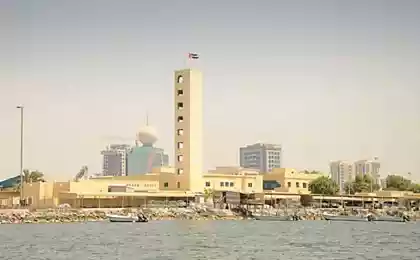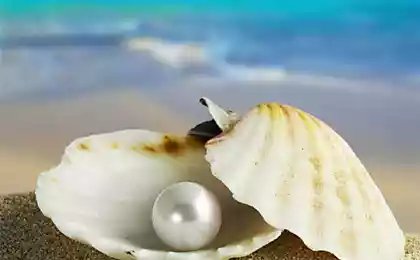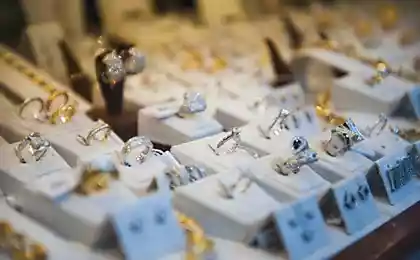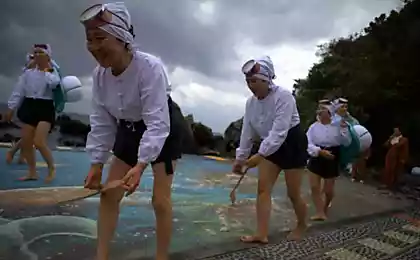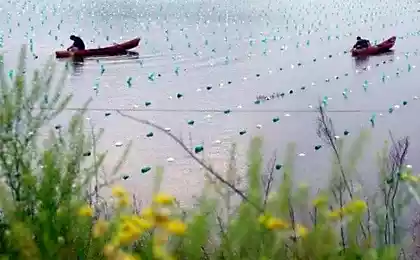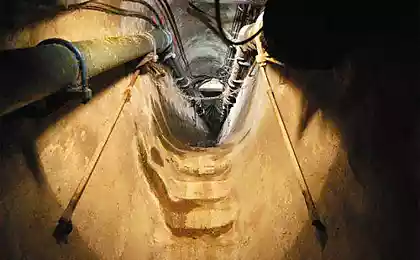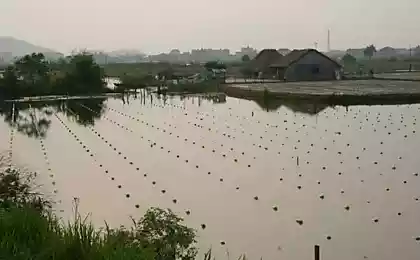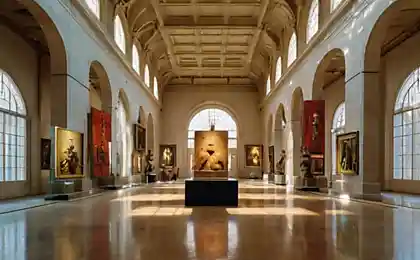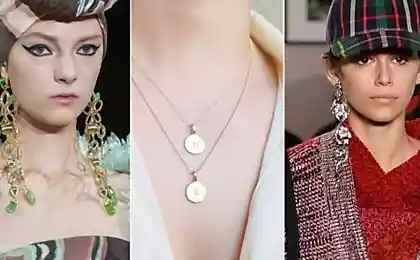3820
Pearl farming in the UAE
Before residents Arab Emirates found oil, they were engaged in pearling in the waters of the Persian Gulf and Gulf of Oman.
First inhabitants of the Arabian Peninsula just dived for pearls wild, but in the 30s of the last century, the Japanese took over the experience and began to cultivate pearls artificially implanting inside the shell of pearl, mother of pearl beads.
In this post you will learn the history of fishing and the cultivation of pearls, pearls see Museum of Ras al-Khaimah and features of the "operation" of the oyster-pearl.
And most importantly, you will learn how to distinguish a real pearl from a fake.
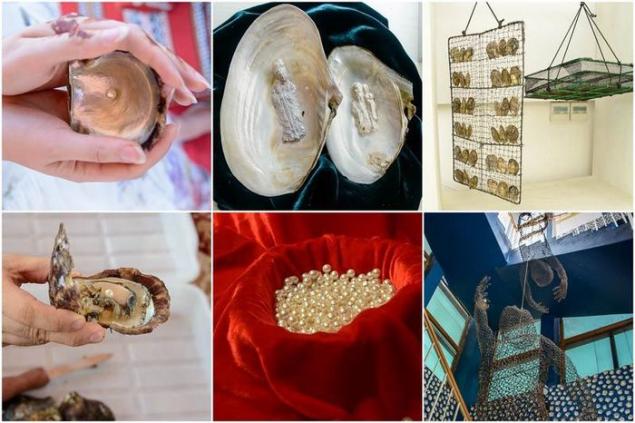
1. Ras Al Khaimah - one of the seven emirates that make federation. He - the most northern, and therefore the temperature here a couple of degrees lower than that of its neighbors. In early September, the daytime temperature is approximately 37-40 degrees. But it is - even out of season. The main influx of tourists in the Emirates begins in October. Then the temperature drops to a more comfortable 30+ degrees.

The organizers of the trip showed us which opened in March this year, Pearl Museum, located right on the shore of the Persian Gulf, which, incidentally, is known locally as the Arab. And all because the Arabs are at odds with the people of Iran, the Persians.
2. The walls are covered with thousands of oyster shells.

Once removed from its valuable pearl stuffing, sink can go into business - nothing can be discarded. Oysters are used for home decoration, furniture inlays, manufacturing accessories and gifts, or just let the fertilizer.
3. As it turned out - shellfish-pearl outside quite plain.
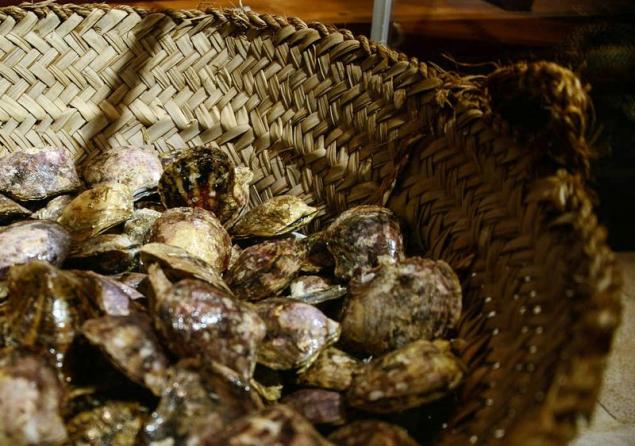
Before pearls here began to grow industrial way, local pearl divers dived to a depth of several meters and collected shellfish in baskets, woven from palm leaves. It was a difficult and dangerous job. To protect against jellyfish used special linen suits, gloves protect the hands and put on his nose clips. To protect your skin from damage, divers rubbed her special oils. Their eyes and ears were open, so often professional pearl divers have lost sight and hearing of the sudden changes in pressure and a long contact with salt water. But their work is always well rewarded - before the turn of the 19th and 20th centuries the Japanese have patented the cultivation of pearls, pearls in the world market was very expensive. And originated in saltwater pearls are still valued more than freshwater pearls because they are more complex in the production / cultivation and have a much more pronounced luster. Today saltwater pearls occupies a small fraction of the world's pearl market: 95% of the total production of the world's fresh water takes.
4. In the photo - a traditional protective suit Arab pearl divers, protection against jellyfish stings.
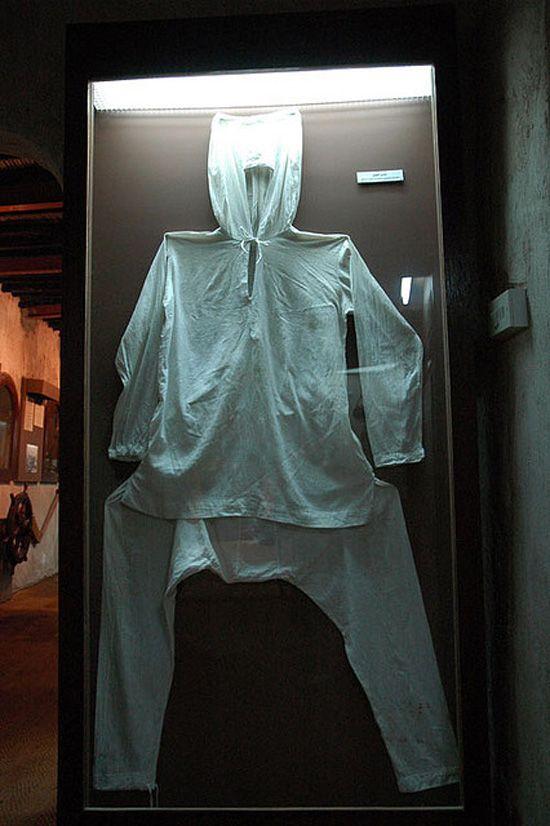
5. Photo - vintage scales and weights, which were used to assess the gems for book cataloging valuable finds and a box for storing precious pearls.
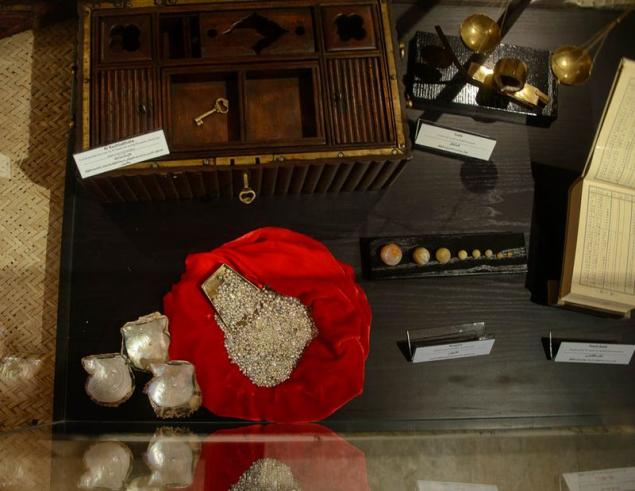
Of course, after the machinery of mass cultivation of pearls prices fell on him, and he became available, but, nevertheless, the cost of a single pearl can vary from a few dollars to several hundred thousand. When evaluating a number of factors into account, and it is not only the color, size, smoothness and shine, but also the opportunity to choose the equivalent of all these qualities, pearls, so they looked together harmoniously.
6. In the stairwell of the museum frozen in eternal impulse of each other two wire nyaryalschika.

7. In the emirate of Ras Al Khaimah, pearls are harvested by Japanese technology. This - cultured pearls, which is called "Akoya" and because of its brilliance is considered a benchmark of quality in the world market.
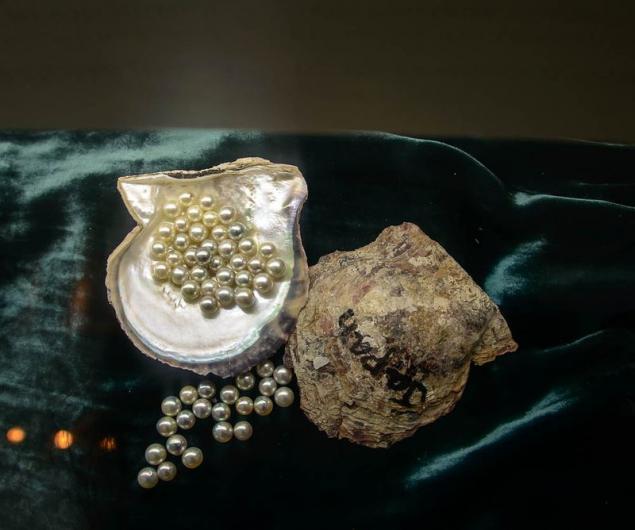
8. In fact - natural pearl is a foreign body, most commonly the parasite larva that falls inside the mollusk. To protect yourself from growing and developing a stranger, shellfish begins to secrete a protective agent - pearl, which envelops the parasite and neutralizes it. If the oyster win this war for survival, dead foreign body inside her year after year continues to grow into new and new pearl layers as long as it may be, will not find a lucky pearl diver. The record for the largest weight and became a huge pearl weighing more than 6 pounds, which in 1930 found in Japanese waters.
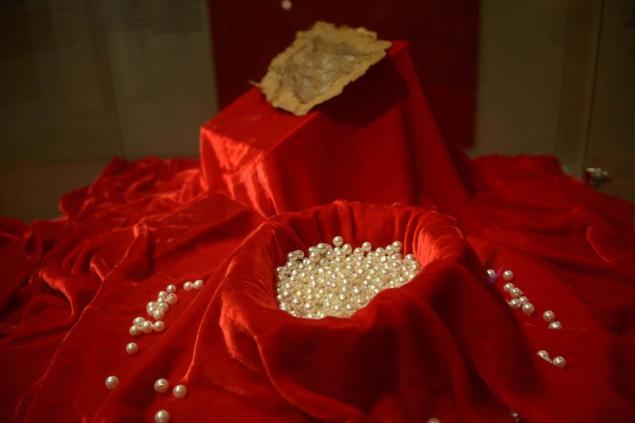
Thus increasing natural pearls, which are now on the world market very small (less than 2 percent).
9. The lion's share of today's market is occupied by cultivated pearls that all his life languishing here in these nets, cages. But before we get there, they get on the table to the "Pearl surgeon».
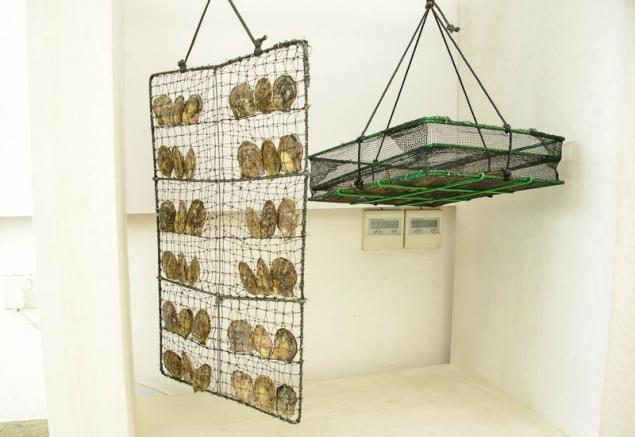
10. This is the master of our blogging company showed how the laying the foundation for future pearl in an oyster.

All the tools that are on the table on a red rag at a demonstration at the museum during the actual process on pearl farms are immersed in a cell with brine. Do not forget that oysters - are living organisms that will fight for survival, and some of them, the weaker will lose this fight. Therefore, tools should be clean, and the process of "operation" takes place as quickly as possible, accurate, sharpened movements experienced specialist.
11. During the "operation" in shellfish inserted wooden struts and prepare special "implant" - usually a small ball. Ras Al Khaimah is used as the core pearl beads made from shells of freshwater mussels grown in the Mississippi River.
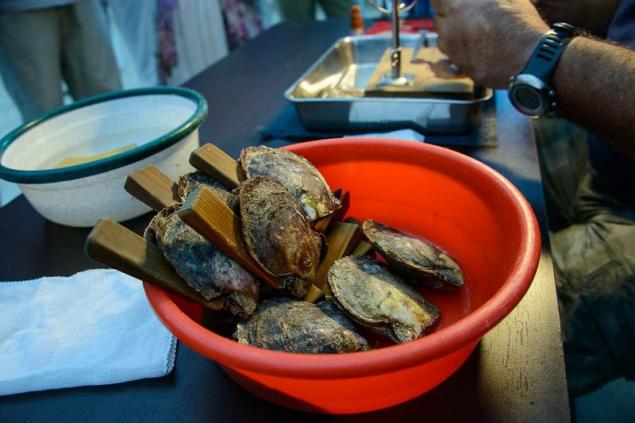
12. But the body to cope better with oysters embedded inside a foreign body and quickly began production of nacre, use a piece of the mantle of a mollusk, pearl mussels of the same species. Cut a strip out of it ...
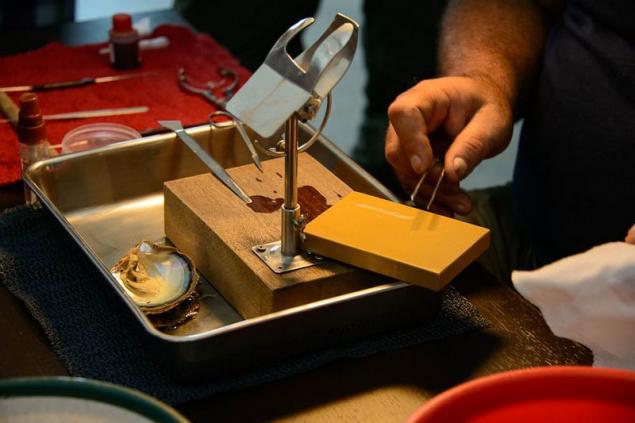
13 ... which is then cut into pieces. Each of the pieces put on the ball, so that he could act as a catalyst for the formation of future pearls.
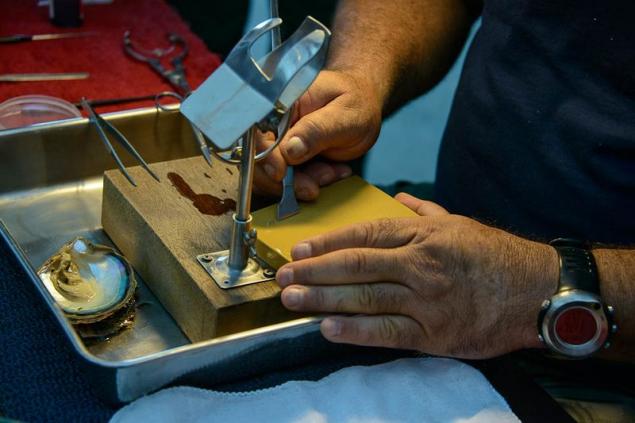
14. oyster ajar, ready to lay the ball is placed on a special holder with struts - a kind of "operating table».
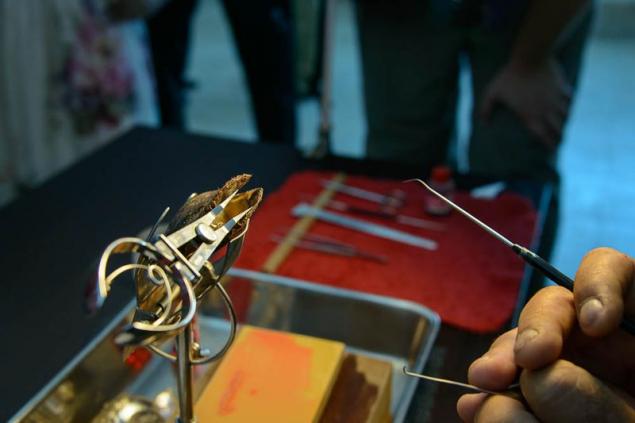
15. Pieces of mantle sprinkle food coloring to make them more noticeable compared to other tissues within the oysters, which were carried out over manipulation. Then passes tab ball gown and a fragment in the reproductive organs of mollusk - gonads. Experienced Mester produces up to 450 of these transactions per day and per oyster he takes no more than 15 seconds.

What happens with oysters after - you know later.
16. And it is - one of the most beautiful, in my opinion, the exhibits - the pearl of Buddhist saints on the walls of shells.
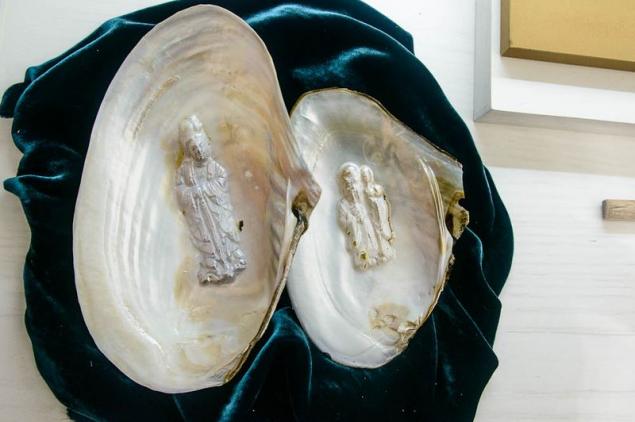
Actually, mankind has tried to cultivate pearls artificially for many centuries ago, long before the Japanese worked his technique and put the process on stream. Back in medieval China inside the shell put miniature figures of animals and tiny images of Buddha, made of metal, bone or clay. They did it not only to get amazing pearl figures, but also to appease the gods and spirits, and thank them for a good catch.
17. Despite the fact that the mass cultivation of pearls appeared more than a hundred years ago, high-quality pearl products are still very expensive. And all because that received the largest gem-quality and hard enough - the percentage of education even when cultured pearl oysters and proper care is quite small. Even more difficult to pick up pearls that would fit together in size, hue, gloss, smoothness, etc.

And if now, when every year millions of farmed shellfish, and is still not easy to get high-quality pearls, then we talk about those times, when production was only natural way - catcher had to pull out and reveal (ie, kill) hundreds of oysters before you come across a pearl of acceptable quality. Shellfish killed thousands and hundreds of thousands, if not for the emergence of culturing pearls, perhaps - all would disappear from the face of the Earth.
18. After visiting the museum, we went for a walk around the bay. I'm not really sure that this boat to give us something like a traditional Arab boat dive for pearls - "Yala" which plied the waters of bays before the arrival of pearl farms.

19. Maybe those fishing boats were more like just such. On the boat, "Yala" that holds a supply of provisions and water, pearl divers went into the sea for a few weeks, and was carried out in all day in search of precious gems in the day making up to three hundred dives. Although, in any case, wild pearl've been here a long time ago do not catch.

Let us return to our shellfish! After the introduction of ball-seated implants oysters in cages, which hung on the ropes a few meters from the shore. Several times a month they are taken out, cleaned of parasites and the build-up, feed, monitor the composition of water, its purity and the degree of salinity. But despite all these concerns in the first month of the oysters die, and some - rejects embedded in them ball-implant. "Remaining in" shellfish, and their less than a third of the total, forming a pair of pearl millimeters in a few months. To grow large as possible to be used in Ras Al Khaimah species of shellfish pearls Akoya - and it is 10-12 mm - take three years.
20. While walking employee RAK Pearls showed us what it looks like pearls grown on their farms.
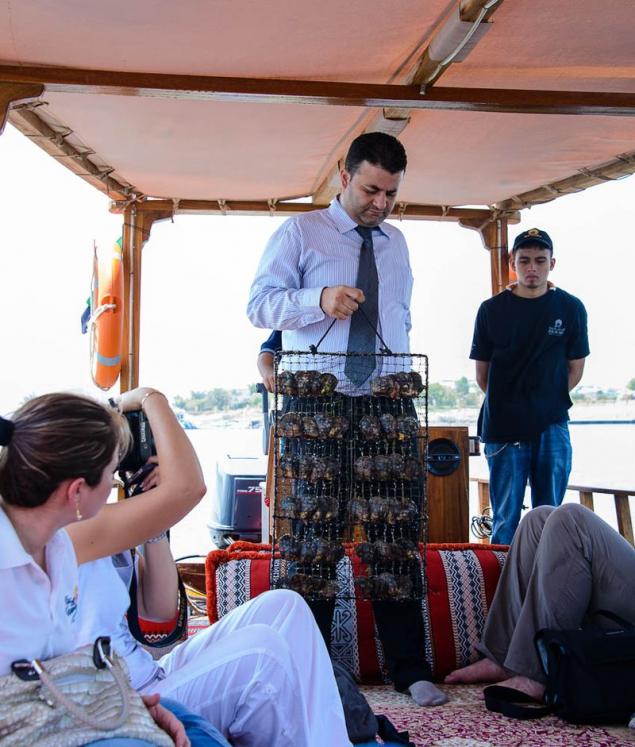
In today's pearl farms, once again not to injure the oysters, they shine X-ray and determine whether there is a pearl inside, and if there is, what she diameter.
21. Here's what the uncovered an oyster with a pearl quality Akoya. She was varaschena on Japanese technology on farms of RAK Pearls, young enough that appeared in the 2005 year. Abbreviation RAK means Ras-Al-Khaima, the name of the emirate.

And where are the pearls of irregular shape, which can not be used for jewelry purposes? They are used in the production of cosmetics, medicines and for other purposes (eg, for the manufacture of artificial pearls).
22. Many are confused and think in terms of artificially cultured pearls. But it is not. Cultured pearls has no relation to the cultivation of the sink. Imitation Pearls tradition for several hundred years - even in the Renaissance pearls made of glass-filled ... with paraffin.
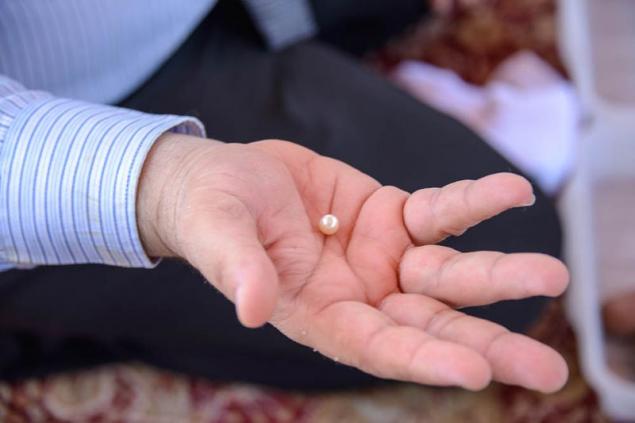
Now simulation options - a lot. This glass, and plastic, and glass beads, carved out of mother of pearl shells, as well as the famous "Majorica pearl", which for 120 years produced on the Spanish island of Mallorca in the Mediterranean Sea. Used in its production alabaster beads that cover the thinnest layers of nacre. To distinguish this from the natural pearl is very difficult. Without cutting the pearl determine originality can only be a specialist with the equipment. But us mere consumers, too, is to learn some of the features and differences - not to be mistaken and buy a fake, we must first look at the color and shape of pearls: artificial pearls will always be homogeneous, the same size and color, without any irregularities and defects . If we make a pearl in the teeth (gnawing it in any case it is not necessary :)), it will be natural to creak softly and be a little rough. Well distinguish painted plastic or glass quite simple - you need to look at the hole pearls, in most cases, will be noticeable layer of paint or glass "insides" beads.
But it turns out there's a catch - pearls can be natural, but it is of poor quality. This product is trying to "elevate" - its tint or irradiated. Colored gems can be determined by considering a magnifying glass. Usually uneven surface of the ball and paint can go to spots. Then there's also important to see the holes in the pearl - usually accumulates more paint here than in other places. A pearl is irradiated to change its color - usually black Tahitian pearls are more valuable, so they also mimic.
23. I found this picture on the Internet to show you what it looks like in the context of cultured pearls.
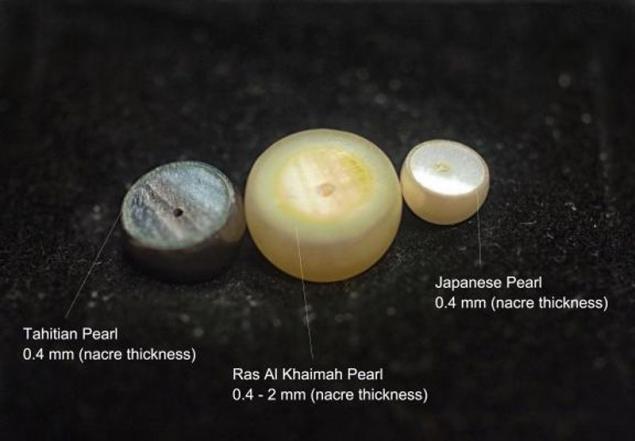
Left - Tahitian pearl, nacre thickness on it - only 0, 4 mm. Right - the Japanese, with the same layer of nacre. And in the middle - the pearl of Ras Al Khaimah. They have a pearlescent layer thickness typically varies from 0 to 4 mm 2.
23. Local pearl is famous for its good quality. In the development of the pearl business, as well as in the tourism, local authorities poured a lot of money from oil money, which, as you know, do not last forever.

When I was preparing this post came across the network to the description of one of the tours for tourists vacationing in the Emirates - anyone can feel like a pearl divers and dressed in a white suit similar to the one you saw above, to dive in shallow water in search of oysters laid out previously with pearls. I think cute and funny. Reminds skeet :) It is worth the entertainment - $ 330. And for those who do not like outdoor games, there is a more conservative option to spend - just go to the store with the pearl museum or one of the many shops in Ras Al Khaimah ...
24. Another very impressed this fact - it turns out, the pearls are not "live" long. Probably because that is a mixture of organic and inorganic substances. This is a very moody gem for that need proper care. Pearls, which are not, "dies". And even if it is to wear and properly care, pearls still does not usually lasts longer 150-200 years. The oldest large pearl of the existing - a pear-shaped "Peregrine", which was caught in the 16th century.
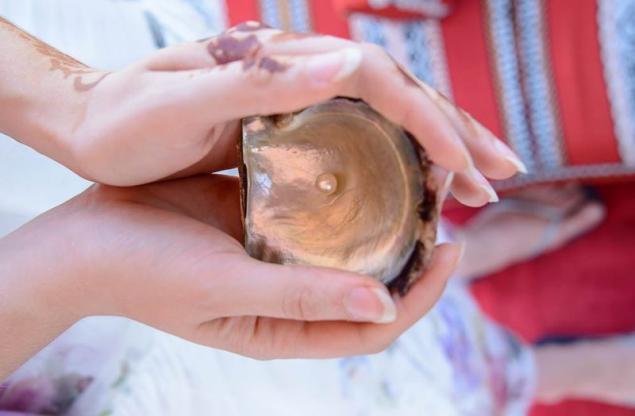
25. And finally - kollazhik of the ornaments that were created from grown in Ras Al Khaimah pearls and mother of pearl ...

Source: bigpicture.ru
First inhabitants of the Arabian Peninsula just dived for pearls wild, but in the 30s of the last century, the Japanese took over the experience and began to cultivate pearls artificially implanting inside the shell of pearl, mother of pearl beads.
In this post you will learn the history of fishing and the cultivation of pearls, pearls see Museum of Ras al-Khaimah and features of the "operation" of the oyster-pearl.
And most importantly, you will learn how to distinguish a real pearl from a fake.

1. Ras Al Khaimah - one of the seven emirates that make federation. He - the most northern, and therefore the temperature here a couple of degrees lower than that of its neighbors. In early September, the daytime temperature is approximately 37-40 degrees. But it is - even out of season. The main influx of tourists in the Emirates begins in October. Then the temperature drops to a more comfortable 30+ degrees.

The organizers of the trip showed us which opened in March this year, Pearl Museum, located right on the shore of the Persian Gulf, which, incidentally, is known locally as the Arab. And all because the Arabs are at odds with the people of Iran, the Persians.
2. The walls are covered with thousands of oyster shells.

Once removed from its valuable pearl stuffing, sink can go into business - nothing can be discarded. Oysters are used for home decoration, furniture inlays, manufacturing accessories and gifts, or just let the fertilizer.
3. As it turned out - shellfish-pearl outside quite plain.

Before pearls here began to grow industrial way, local pearl divers dived to a depth of several meters and collected shellfish in baskets, woven from palm leaves. It was a difficult and dangerous job. To protect against jellyfish used special linen suits, gloves protect the hands and put on his nose clips. To protect your skin from damage, divers rubbed her special oils. Their eyes and ears were open, so often professional pearl divers have lost sight and hearing of the sudden changes in pressure and a long contact with salt water. But their work is always well rewarded - before the turn of the 19th and 20th centuries the Japanese have patented the cultivation of pearls, pearls in the world market was very expensive. And originated in saltwater pearls are still valued more than freshwater pearls because they are more complex in the production / cultivation and have a much more pronounced luster. Today saltwater pearls occupies a small fraction of the world's pearl market: 95% of the total production of the world's fresh water takes.
4. In the photo - a traditional protective suit Arab pearl divers, protection against jellyfish stings.

5. Photo - vintage scales and weights, which were used to assess the gems for book cataloging valuable finds and a box for storing precious pearls.

Of course, after the machinery of mass cultivation of pearls prices fell on him, and he became available, but, nevertheless, the cost of a single pearl can vary from a few dollars to several hundred thousand. When evaluating a number of factors into account, and it is not only the color, size, smoothness and shine, but also the opportunity to choose the equivalent of all these qualities, pearls, so they looked together harmoniously.
6. In the stairwell of the museum frozen in eternal impulse of each other two wire nyaryalschika.

7. In the emirate of Ras Al Khaimah, pearls are harvested by Japanese technology. This - cultured pearls, which is called "Akoya" and because of its brilliance is considered a benchmark of quality in the world market.

8. In fact - natural pearl is a foreign body, most commonly the parasite larva that falls inside the mollusk. To protect yourself from growing and developing a stranger, shellfish begins to secrete a protective agent - pearl, which envelops the parasite and neutralizes it. If the oyster win this war for survival, dead foreign body inside her year after year continues to grow into new and new pearl layers as long as it may be, will not find a lucky pearl diver. The record for the largest weight and became a huge pearl weighing more than 6 pounds, which in 1930 found in Japanese waters.

Thus increasing natural pearls, which are now on the world market very small (less than 2 percent).
9. The lion's share of today's market is occupied by cultivated pearls that all his life languishing here in these nets, cages. But before we get there, they get on the table to the "Pearl surgeon».

10. This is the master of our blogging company showed how the laying the foundation for future pearl in an oyster.

All the tools that are on the table on a red rag at a demonstration at the museum during the actual process on pearl farms are immersed in a cell with brine. Do not forget that oysters - are living organisms that will fight for survival, and some of them, the weaker will lose this fight. Therefore, tools should be clean, and the process of "operation" takes place as quickly as possible, accurate, sharpened movements experienced specialist.
11. During the "operation" in shellfish inserted wooden struts and prepare special "implant" - usually a small ball. Ras Al Khaimah is used as the core pearl beads made from shells of freshwater mussels grown in the Mississippi River.

12. But the body to cope better with oysters embedded inside a foreign body and quickly began production of nacre, use a piece of the mantle of a mollusk, pearl mussels of the same species. Cut a strip out of it ...

13 ... which is then cut into pieces. Each of the pieces put on the ball, so that he could act as a catalyst for the formation of future pearls.

14. oyster ajar, ready to lay the ball is placed on a special holder with struts - a kind of "operating table».

15. Pieces of mantle sprinkle food coloring to make them more noticeable compared to other tissues within the oysters, which were carried out over manipulation. Then passes tab ball gown and a fragment in the reproductive organs of mollusk - gonads. Experienced Mester produces up to 450 of these transactions per day and per oyster he takes no more than 15 seconds.

What happens with oysters after - you know later.
16. And it is - one of the most beautiful, in my opinion, the exhibits - the pearl of Buddhist saints on the walls of shells.

Actually, mankind has tried to cultivate pearls artificially for many centuries ago, long before the Japanese worked his technique and put the process on stream. Back in medieval China inside the shell put miniature figures of animals and tiny images of Buddha, made of metal, bone or clay. They did it not only to get amazing pearl figures, but also to appease the gods and spirits, and thank them for a good catch.
17. Despite the fact that the mass cultivation of pearls appeared more than a hundred years ago, high-quality pearl products are still very expensive. And all because that received the largest gem-quality and hard enough - the percentage of education even when cultured pearl oysters and proper care is quite small. Even more difficult to pick up pearls that would fit together in size, hue, gloss, smoothness, etc.

And if now, when every year millions of farmed shellfish, and is still not easy to get high-quality pearls, then we talk about those times, when production was only natural way - catcher had to pull out and reveal (ie, kill) hundreds of oysters before you come across a pearl of acceptable quality. Shellfish killed thousands and hundreds of thousands, if not for the emergence of culturing pearls, perhaps - all would disappear from the face of the Earth.
18. After visiting the museum, we went for a walk around the bay. I'm not really sure that this boat to give us something like a traditional Arab boat dive for pearls - "Yala" which plied the waters of bays before the arrival of pearl farms.

19. Maybe those fishing boats were more like just such. On the boat, "Yala" that holds a supply of provisions and water, pearl divers went into the sea for a few weeks, and was carried out in all day in search of precious gems in the day making up to three hundred dives. Although, in any case, wild pearl've been here a long time ago do not catch.

Let us return to our shellfish! After the introduction of ball-seated implants oysters in cages, which hung on the ropes a few meters from the shore. Several times a month they are taken out, cleaned of parasites and the build-up, feed, monitor the composition of water, its purity and the degree of salinity. But despite all these concerns in the first month of the oysters die, and some - rejects embedded in them ball-implant. "Remaining in" shellfish, and their less than a third of the total, forming a pair of pearl millimeters in a few months. To grow large as possible to be used in Ras Al Khaimah species of shellfish pearls Akoya - and it is 10-12 mm - take three years.
20. While walking employee RAK Pearls showed us what it looks like pearls grown on their farms.

In today's pearl farms, once again not to injure the oysters, they shine X-ray and determine whether there is a pearl inside, and if there is, what she diameter.
21. Here's what the uncovered an oyster with a pearl quality Akoya. She was varaschena on Japanese technology on farms of RAK Pearls, young enough that appeared in the 2005 year. Abbreviation RAK means Ras-Al-Khaima, the name of the emirate.

And where are the pearls of irregular shape, which can not be used for jewelry purposes? They are used in the production of cosmetics, medicines and for other purposes (eg, for the manufacture of artificial pearls).
22. Many are confused and think in terms of artificially cultured pearls. But it is not. Cultured pearls has no relation to the cultivation of the sink. Imitation Pearls tradition for several hundred years - even in the Renaissance pearls made of glass-filled ... with paraffin.

Now simulation options - a lot. This glass, and plastic, and glass beads, carved out of mother of pearl shells, as well as the famous "Majorica pearl", which for 120 years produced on the Spanish island of Mallorca in the Mediterranean Sea. Used in its production alabaster beads that cover the thinnest layers of nacre. To distinguish this from the natural pearl is very difficult. Without cutting the pearl determine originality can only be a specialist with the equipment. But us mere consumers, too, is to learn some of the features and differences - not to be mistaken and buy a fake, we must first look at the color and shape of pearls: artificial pearls will always be homogeneous, the same size and color, without any irregularities and defects . If we make a pearl in the teeth (gnawing it in any case it is not necessary :)), it will be natural to creak softly and be a little rough. Well distinguish painted plastic or glass quite simple - you need to look at the hole pearls, in most cases, will be noticeable layer of paint or glass "insides" beads.
But it turns out there's a catch - pearls can be natural, but it is of poor quality. This product is trying to "elevate" - its tint or irradiated. Colored gems can be determined by considering a magnifying glass. Usually uneven surface of the ball and paint can go to spots. Then there's also important to see the holes in the pearl - usually accumulates more paint here than in other places. A pearl is irradiated to change its color - usually black Tahitian pearls are more valuable, so they also mimic.
23. I found this picture on the Internet to show you what it looks like in the context of cultured pearls.

Left - Tahitian pearl, nacre thickness on it - only 0, 4 mm. Right - the Japanese, with the same layer of nacre. And in the middle - the pearl of Ras Al Khaimah. They have a pearlescent layer thickness typically varies from 0 to 4 mm 2.
23. Local pearl is famous for its good quality. In the development of the pearl business, as well as in the tourism, local authorities poured a lot of money from oil money, which, as you know, do not last forever.

When I was preparing this post came across the network to the description of one of the tours for tourists vacationing in the Emirates - anyone can feel like a pearl divers and dressed in a white suit similar to the one you saw above, to dive in shallow water in search of oysters laid out previously with pearls. I think cute and funny. Reminds skeet :) It is worth the entertainment - $ 330. And for those who do not like outdoor games, there is a more conservative option to spend - just go to the store with the pearl museum or one of the many shops in Ras Al Khaimah ...
24. Another very impressed this fact - it turns out, the pearls are not "live" long. Probably because that is a mixture of organic and inorganic substances. This is a very moody gem for that need proper care. Pearls, which are not, "dies". And even if it is to wear and properly care, pearls still does not usually lasts longer 150-200 years. The oldest large pearl of the existing - a pear-shaped "Peregrine", which was caught in the 16th century.

25. And finally - kollazhik of the ornaments that were created from grown in Ras Al Khaimah pearls and mother of pearl ...

Source: bigpicture.ru

